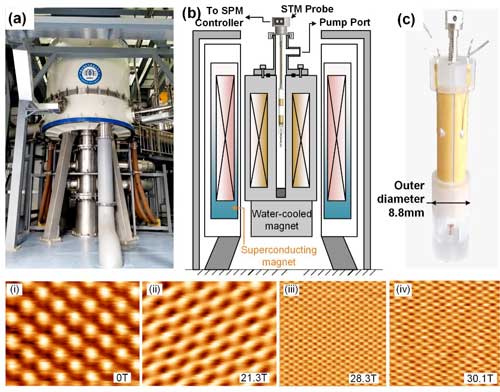| Jun 25, 2020 | |
Researchers realize atomic resolution imaging at 30.1 T in hybrid magnet(Nanowerk News) Researchers have constructed the world’s first atomically resolved scanning tunneling microscope (STM) in a hybrid magnet to obtain atomic resolved STM images of graphite in an ultra-high 30.1 T magnetic field and bore of 32mm diameter setting the highest magnetic field for the hybrid magnet,and the same time marking a new magnetic field record for any atomic resolution measurement. |
|
| This work was carried out by Prof. LU Qingyou's group at the High Magnetic Field Laboratory, Hefei Institutes of Physical Science. | |
| According to the team, ambient condition STM imaging with atomic resolution in the hybrid magnet has also been achieved, with a applied field of 27.5 T. Their work were published on Ultramicroscopy ("30 T scanning tunnelling microscope in a hybrid magnet with essentially non-metallic design") and Review of Scientific Instruments ("A hybrid magnet based scanning tunneling microscope"), respectively. This is another successful attempt since the world's first atomically resolved STM in the water-cooled magnet (with an applied field of 27 T) achieved by LU's group. | |
 |
|
| The hybrid magnet (HM) STM system: (a) The photograph of HM; (b) Schematic of the HM-STM system; (c) The picture of STM head unit; (i-iv) the atomic resolution images of graphite (raw data). (Image courtesy of the research team) | |
| As an important extreme physical condition, the magnetic field, as a research platform enabling scientists with extreme conditions, is expected to be as high as possible. Strong static magnetic field can be produced by a superconducting magnet, but only achieve as high as 20 T, while a water-cooled magnet can produce a much stronger magnetic field, making the strongest steady state magnetic field come from the hybrid magnet, in which a water-cooled magnet is co-axially enclosed and mounted inside a large-bore superconducting magnet. | |
| However, both of the magnets mentioned above produce harsh vibration due to the high pressure cooling water, which has long been a destroying factor for any real space atomic resolution microscopy measurement. | |
| Now, such a tremendous barrier has been removed, which will fill in the huge blank of potentially more than 20 T between the superconducting and hybrid magnets for atomic resolution measurement. | |
| Previous results obtained in ultra-high magnetic fields via macroscopic transport measurements can now be re-scrutinized by imaging the local density of states (LDOS) of electrons at a particular site of atom or vacant and comparing with the microscopic density functional theory of quantum mechanics. Such applications can easily include field-induced local quenching of high temperature superconductivity, unsaturated magneto-resistive effect, etc. | |
| Prof. LU's group has for years been dedicated to the developments of various harsh condition STMs, and invented a variety of highly rigid and compact piezoelectric motors with large output force, including GeckoDrive, TunaDriver, PandaDrive and SpiderDrive etc., which are suitable for building highly stable atomic resolution STMs in harsh vibration conditions and narrow spaces. Many of these STMs has been realized recently, including the continuous flow cryostat (20mm-diameter bore) based STM and the first cryogen-free (dry) superconducting magnet based STM. | |
| These all have contributed to the final success in achieving atomic resolution in the super-harsh but ultra-high field hybrid magnet. From now on, the atomic resolution measurement can be expected in any arbitrarily high static magnetic field. |
| Source: Chinese Academy of Sciences | |
|
Subscribe to a free copy of one of our daily Nanowerk Newsletter Email Digests with a compilation of all of the day's news. |
